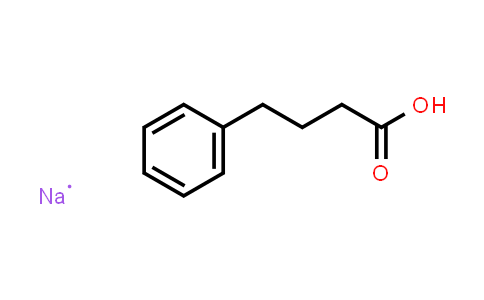Introduction of 1716-12-7 :
Benzenebutyric acid sodium (4-Phenylbutyric acid sodium) is an inhibitor of HDAC and endoplasmic reticulum (ER) stress, used in cancer and infection research. IC50 & Target: HDAC[1], ER[3] In Vitro: Benzenebutyric acid sodium (Sodium phenylbutyrate) is an inhibitor of HDAC, inhibits the growth of NSCLC Cell Lines at 2 mM. Benzenebutyric acid sodium in combination with ciglitizone results in enhanced growth arrest of cancer cells[1]. Benzenebutyric acid sodium (Sodium phenylbutyrate; 0-5 mM) inhibits ASFV infection in a dose-dependent manner. Benzenebutyric acid sodium also inhibits the ASFV late protein synthesis and disrupts the virus-induced H3K9/K14 hypoacetylation status. Benzenebutyric acid sodium and Enrofloxacin act synergistically to abolish ASFV replication[2]. Addition of Bafilomycin A1 results in accumulation of LC3II, whereas Benzenebutyric acid (4-PBA) substantially reduces this accumulation. LPS decreases the level of p62, whereas Benzenebutyric acid reverses this decrease upon LPS stimulation for 48 h. The percentage of cells with LPS-induced AVOs is increased at 48 h, whereas Benzenebutyric acid significantly reduces this percentage. Specifically, the percentage of cells with AVOs decreases from 61.6% to 53.1% upon Benzenebutyric acid treatment, supporting that Benzenebutyric acid inhibits LPS-induced autophagy. As a positive control for autophagy inhibition, bafilomycin A1 is used. The percentage of cells with LPS-induced AVOs is reduced by bafilomycin A1 treatment. The decreased OC area and fusion index observed after Benzenebutyric acid treatment are not observed with knockdown of ATG7. Inhibition of NF-κB using BAY 11-7082 and JSH23 reduce the LC3 II level upon LPS stimulation and completely abolish the inhibitory effect of Benzenebutyric acid on LPS-induced effects[3]. In Vivo: LPS induces significant bone loss and decreases bone mineral density (BMD), bone volume (BV/TV), and trabecular thickness (Tb. Th) compared with PBS alone, whereas trabecular space (Tb. Sp.) is increased. Benzenebutyric acid sodium (Sodium phenylbutyrate) attenuates LPS-induced bone loss. Treatment with Benzenebutyric acid sodium increases BMD, BV/TV, and Tb. Th. compared with LPS alone, in addition to decreasing the enlargement of Tb. Sp., but no change is observed when mice are treated with Benzenebutyric acid sodium alone. OC.S/BS as assessed by TRAP staining is also significantly reduced when Benzenebutyric acid sodium is administered to LPS-treated mice. However, OC.N/BS tends to decrease, although not with statistical significance, when mice are treated with Benzenebutyric acid sodium and LPS. These results indicate that the effect of Benzenebutyric acid sodium on OC from LPS-treated mice is to reduce its size rather than number. Consistent with these findings, a marker of bone resorption in vivo, serum CTX-1 which is elevated by LPS treatment is decreased when Benzenebutyric acid sodium administered to LPS-injected mice. However, co-treatment with Benzenebutyric acid sodium do not significantly affect the levels of serum ALP and osteocalcin, 2 markers of bone formation in vivo, compared with LPS alone. Benzenebutyric acid sodium also reduces the LPS-induced rise in serum MCP-1, indicating that Benzenebutyric acid sodium decreases systemic inflammation induced by LPS[3].
